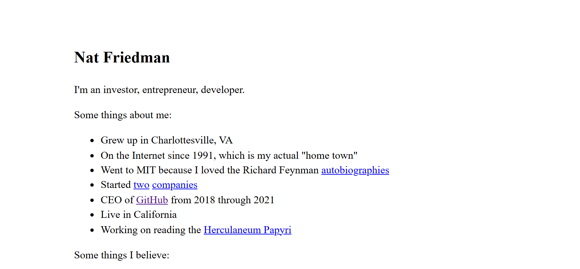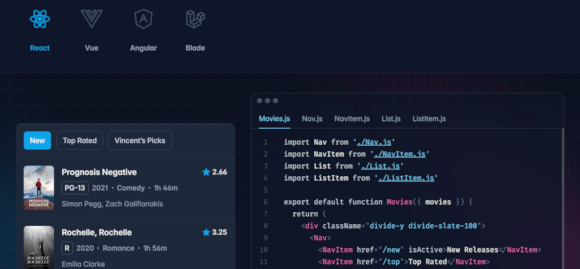The Curse of Markdown
And the content website wasteland


The Lean-Rich Spectrum
We can think of content websites on a scale from lean to rich.
A good example of a lean content website is nat.org, it's just text with minimal styling.
Making nat.org richer—by adding interactive elements or a fancy layout—won't add much value to its purpose, only distraction from the content.


A great example of a rich content website is the Tailwind CSS landing page.
It uses interactive examples, animations, and engaging visuals to highlight how TailwindCSS works and what it can do.
Making the site leaner—by removing these rich elements—would make it harder for visitors to understand what TailwindCSS offers.


Along the spectrum from lean to rich, we can find websites like:
- Static blogs
- Documentation websites
- Visual essays
- Explorable explanations
- Interactive tutorials


The Content-Richness Sweet Spot
For each piece of content, there is a sweet spot of richness. The perfect richness level depends on how complex the content is.
Not enough richness makes it harder for the author to express their ideas and for the reader to understand them.
Too much richness requires extra effort from the author and leads to more distractions for the reader.


The Cost of Richness
Making a website richer requires more effort.
In a world without Markdown or any markup language other than HTML, the cost of building a website grows linearly with its richness. A slightly richer website requires a slightly higher effort to build.


If we add Markdown back into the equation, the cost of building lean websites becomes much lower. Markdown’s simplicity and tooling make it almost effortless to create text-focused sites like blogs or documentation.
Tools like MDX, Markdoc, and plugins extend the range of websites that can be built with Markdown, allowing for richer websites with some extra effort.


The Tradeoff Wall
But Markdown has its limits. Beyond a certain level, Markdown stops being helpful and the cost of building remains as high as before.
This jump in cost disrupts the trade-off between richness and effort. For content with a sweet spot just beyond Markdown’s limits, the additional effort often seems too high for the small gain in richness, leading to a preference for staying with Markdown and sacrificing richness.


The impact of Markdown becomes clear if we plot a random sample of content websites. (Disclaimer: the data is made-up, based on my perception of the state of the web)
Most websites are on the lean side. A few outliers sit just beyond Markdown’s limits. At the richer end we see a decent share of websites, where the tradeoff between effort and richness starts to make sense again.


The Website Wasteland
That sparse area just beyond the limits of Markdown is of vital importance to the web. These websites are not only a joy to read but also the ones that explore the web's possibilities, embracing the medium and evoking a truly web-native feel.
Currently, these websites are outliers created by individuals who care deeply about the reader's experience or by companies willing to invest extra effort. We need more of them.


Repopulating the Wasteland
To bring more websites into this space, we need tools that lower the effort required to create richer content.
Some new tools address this by focusing on specific content-presentation types, like Swift-DocC, that compiles Swift into rich developer documentation, or TutorialKit a tool for creating interactive tutorials.


While those tools are great, they target very specific types of websites. This was also the case with Code Hike before version 1.0—a tool I built that was limited to a set of layouts without much flexibility.
But I believe that more general-purpose tools are possible. Tools that bring the trade-off between richness and effort back into balance.
That's my vision for Code Hike v1, and the idea behind fine-grained markdown.


Why does it matter?
Imagine how many ideas are held back because their authors don’t have the right tools to express them.
By lowering the barriers to richer content websites, we can unlock the web’s unmatched potential to support the full spectrum of richness, allowing every idea to be expressed in the most fitting way for its depth and complexity.


The Lean-Rich Spectrum
We can think of content websites on a scale from lean to rich.
A good example of a lean content website is nat.org, it's just text with minimal styling.
Making nat.org richer—by adding interactive elements or a fancy layout—won't add much value to its purpose, only distraction from the content.
A great example of a rich content website is the Tailwind CSS landing page.
It uses interactive examples, animations, and engaging visuals to highlight how TailwindCSS works and what it can do.
Making the site leaner—by removing these rich elements—would make it harder for visitors to understand what TailwindCSS offers.
Along the spectrum from lean to rich, we can find websites like:
- Static blogs
- Documentation websites
- Visual essays
- Explorable explanations
- Interactive tutorials
The Content-Richness Sweet Spot
For each piece of content, there is a sweet spot of richness. The perfect richness level depends on how complex the content is.
Not enough richness makes it harder for the author to express their ideas and for the reader to understand them.
Too much richness requires extra effort from the author and leads to more distractions for the reader.
The Cost of Richness
Making a website richer requires more effort.
In a world without Markdown or any markup language other than HTML, the cost of building a website grows linearly with its richness. A slightly richer website requires a slightly higher effort to build.
If we add Markdown back into the equation, the cost of building lean websites becomes much lower. Markdown’s simplicity and tooling make it almost effortless to create text-focused sites like blogs or documentation.
Tools like MDX, Markdoc, and plugins extend the range of websites that can be built with Markdown, allowing for richer websites with some extra effort.
The Tradeoff Wall
But Markdown has its limits. Beyond a certain level, Markdown stops being helpful and the cost of building remains as high as before.
This jump in cost disrupts the trade-off between richness and effort. For content with a sweet spot just beyond Markdown’s limits, the additional effort often seems too high for the small gain in richness, leading to a preference for staying with Markdown and sacrificing richness.
The impact of Markdown becomes clear if we plot a random sample of content websites. (Disclaimer: the data is made-up, based on my perception of the state of the web)
Most websites are on the lean side. A few outliers sit just beyond Markdown’s limits. At the richer end we see a decent share of websites, where the tradeoff between effort and richness starts to make sense again.
The Website Wasteland
That sparse area just beyond the limits of Markdown is of vital importance to the web. These websites are not only a joy to read but also the ones that explore the web's possibilities, embracing the medium and evoking a truly web-native feel.
Currently, these websites are outliers created by individuals who care deeply about the reader's experience or by companies willing to invest extra effort. We need more of them.
Repopulating the Wasteland
To bring more websites into this space, we need tools that lower the effort required to create richer content.
Some new tools address this by focusing on specific content-presentation types, like Swift-DocC, that compiles Swift into rich developer documentation, or TutorialKit a tool for creating interactive tutorials.
While those tools are great, they target very specific types of websites. This was also the case with Code Hike before version 1.0—a tool I built that was limited to a set of layouts without much flexibility.
But I believe that more general-purpose tools are possible. Tools that bring the trade-off between richness and effort back into balance.
That's my vision for Code Hike v1, and the idea behind fine-grained markdown.
Why does it matter?
Imagine how many ideas are held back because their authors don’t have the right tools to express them.
By lowering the barriers to richer content websites, we can unlock the web’s unmatched potential to support the full spectrum of richness, allowing every idea to be expressed in the most fitting way for its depth and complexity.